Leadership in Business: A Critical Review of Key Leadership Theories
VerifiedAdded on 2023/06/03
|9
|1670
|173
Report
AI Summary
This report provides an in-depth analysis of various leadership theories relevant to business, including autocratic, situational and contingency, systems, and transformational leadership. Each theory is critically examined, highlighting its strengths and weaknesses. Autocratic leadership is noted for its quick decision-making but potential for hostility and demotivation. Situational leadership's strength lies in its adaptability, while contingency leadership emphasizes matching leadership style to the situation, though both may lack proactive solutions. Systems leadership enhances organizational adaptability but can cause decision delays, and transformational leadership fosters change but may face resistance. The report concludes that effective leadership requires adapting traits to specific situations, leveraging the strengths and mitigating the weaknesses of each theory. Desklib provides this assignment solution and many other resources to aid students in their studies.
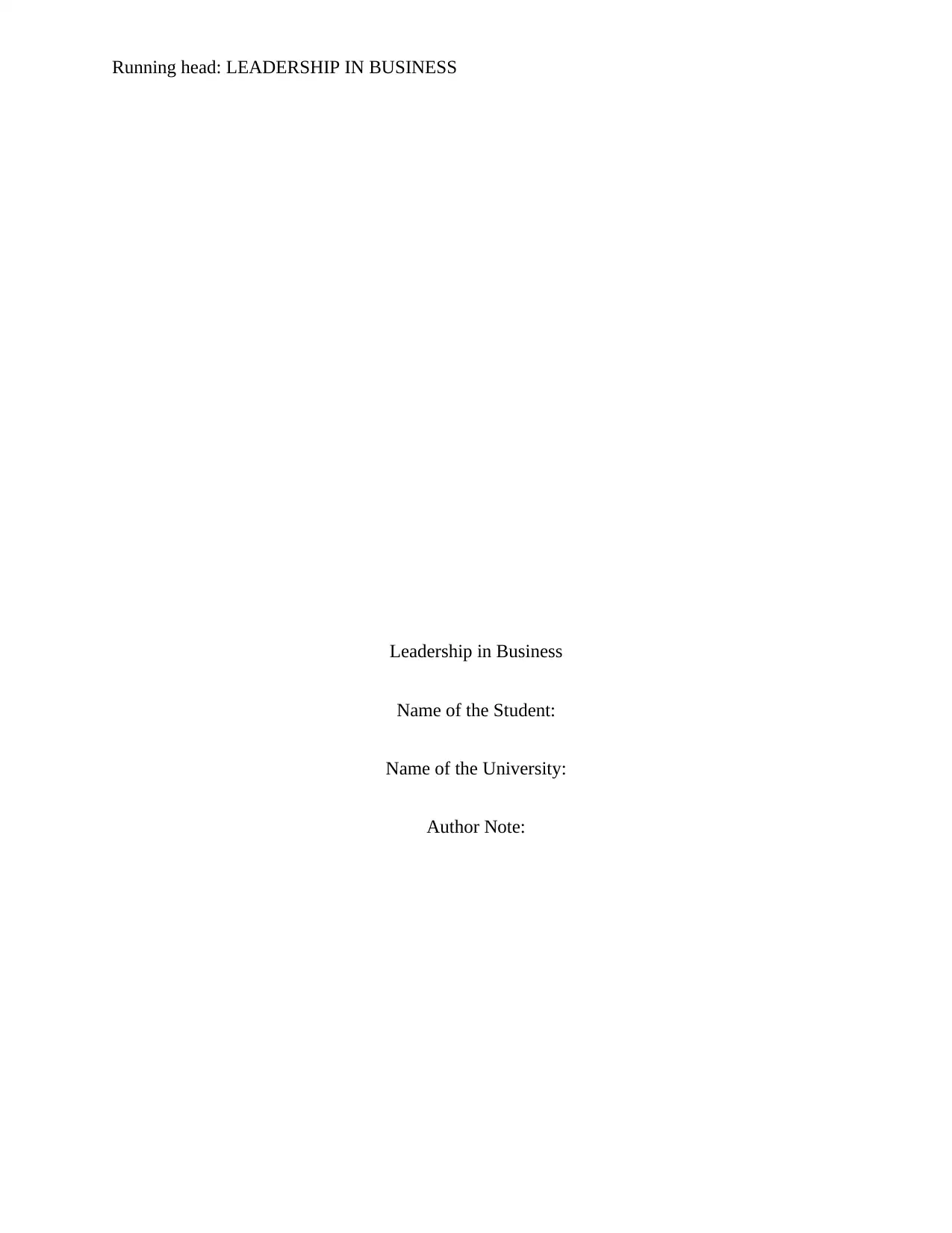
Running head: LEADERSHIP IN BUSINESS
Leadership in Business
Name of the Student:
Name of the University:
Author Note:
Leadership in Business
Name of the Student:
Name of the University:
Author Note:
Paraphrase This Document
Need a fresh take? Get an instant paraphrase of this document with our AI Paraphraser
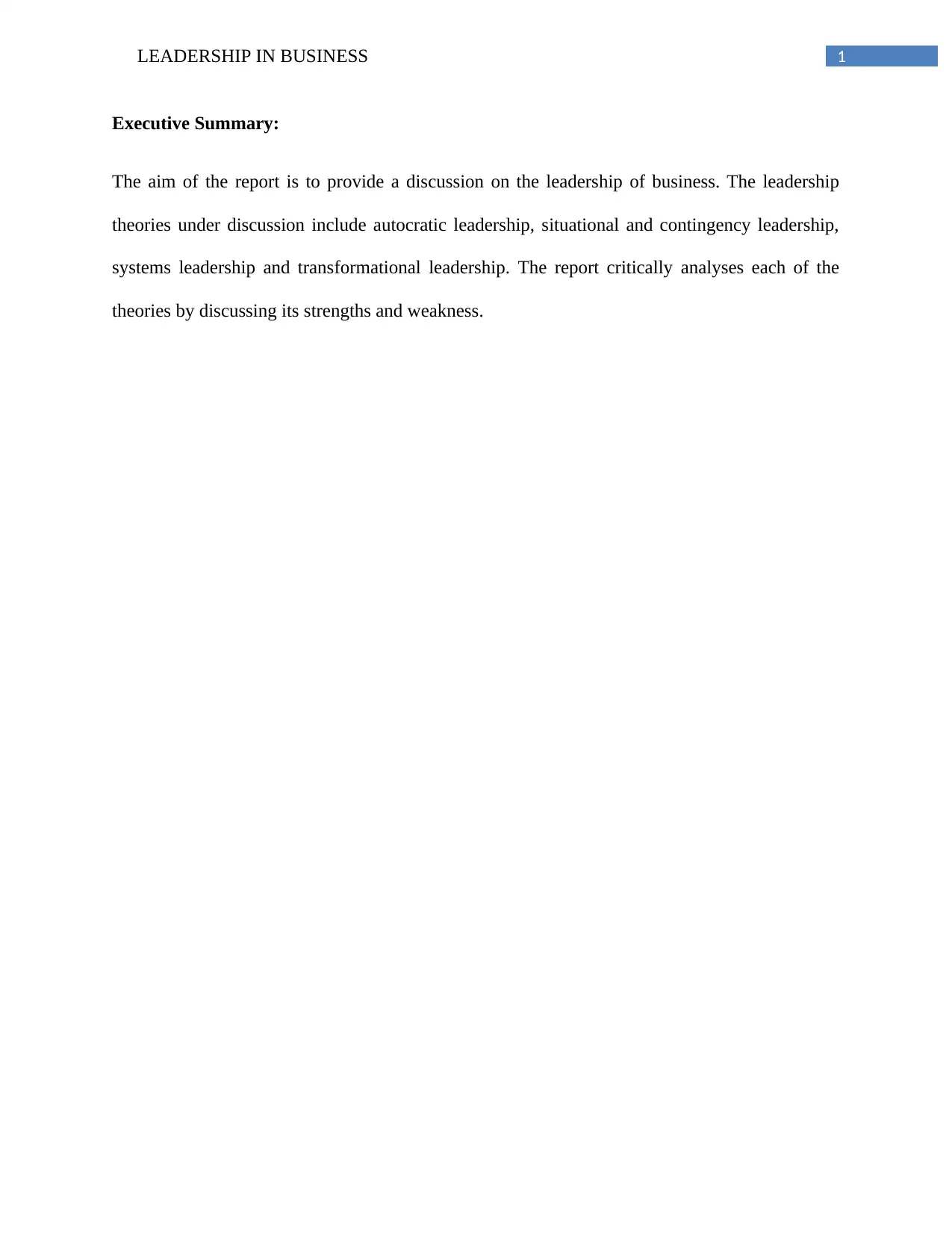
1LEADERSHIP IN BUSINESS
Executive Summary:
The aim of the report is to provide a discussion on the leadership of business. The leadership
theories under discussion include autocratic leadership, situational and contingency leadership,
systems leadership and transformational leadership. The report critically analyses each of the
theories by discussing its strengths and weakness.
Executive Summary:
The aim of the report is to provide a discussion on the leadership of business. The leadership
theories under discussion include autocratic leadership, situational and contingency leadership,
systems leadership and transformational leadership. The report critically analyses each of the
theories by discussing its strengths and weakness.
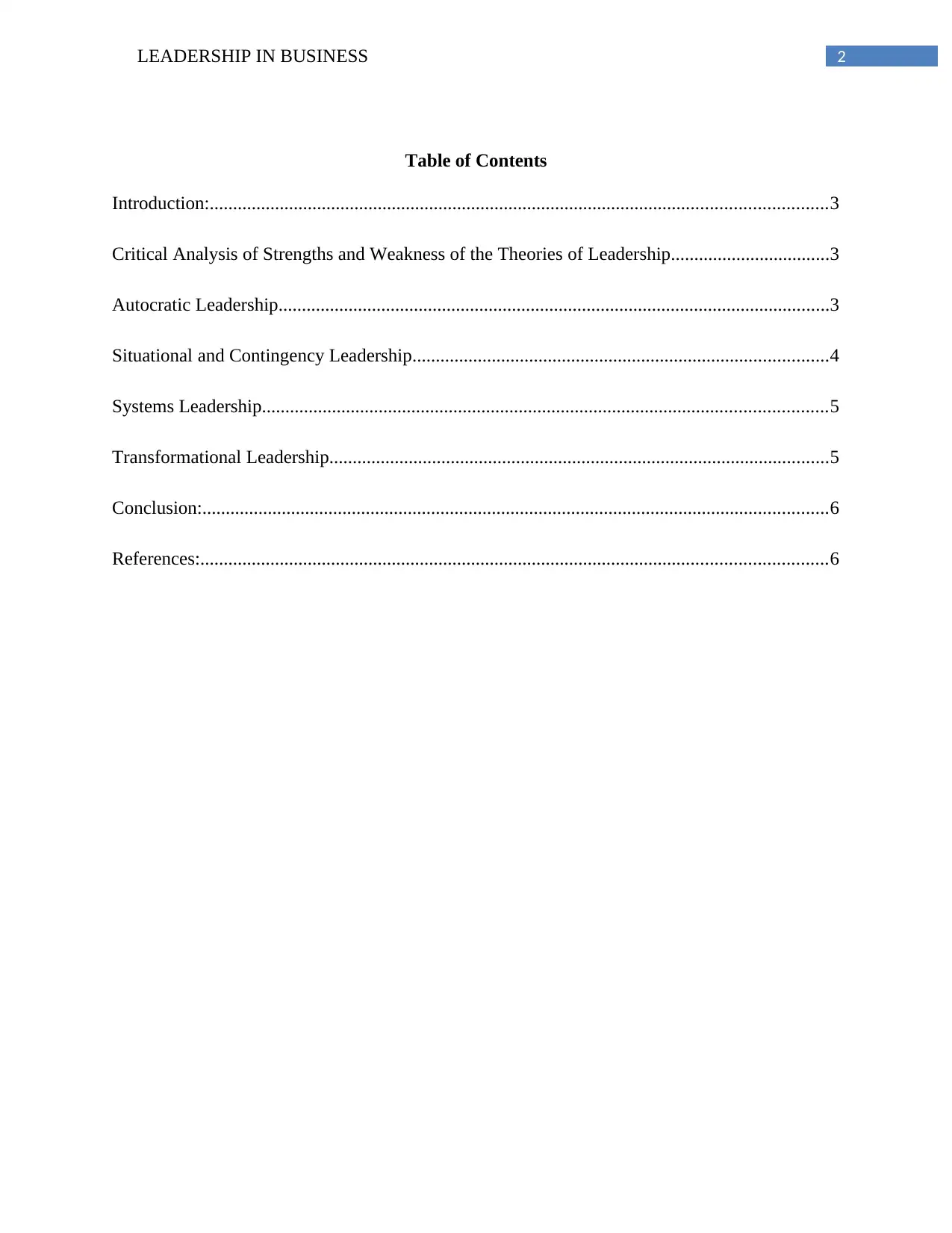
2LEADERSHIP IN BUSINESS
Table of Contents
Introduction:....................................................................................................................................3
Critical Analysis of Strengths and Weakness of the Theories of Leadership..................................3
Autocratic Leadership......................................................................................................................3
Situational and Contingency Leadership.........................................................................................4
Systems Leadership.........................................................................................................................5
Transformational Leadership...........................................................................................................5
Conclusion:......................................................................................................................................6
References:......................................................................................................................................6
Table of Contents
Introduction:....................................................................................................................................3
Critical Analysis of Strengths and Weakness of the Theories of Leadership..................................3
Autocratic Leadership......................................................................................................................3
Situational and Contingency Leadership.........................................................................................4
Systems Leadership.........................................................................................................................5
Transformational Leadership...........................................................................................................5
Conclusion:......................................................................................................................................6
References:......................................................................................................................................6
⊘ This is a preview!⊘
Do you want full access?
Subscribe today to unlock all pages.

Trusted by 1+ million students worldwide
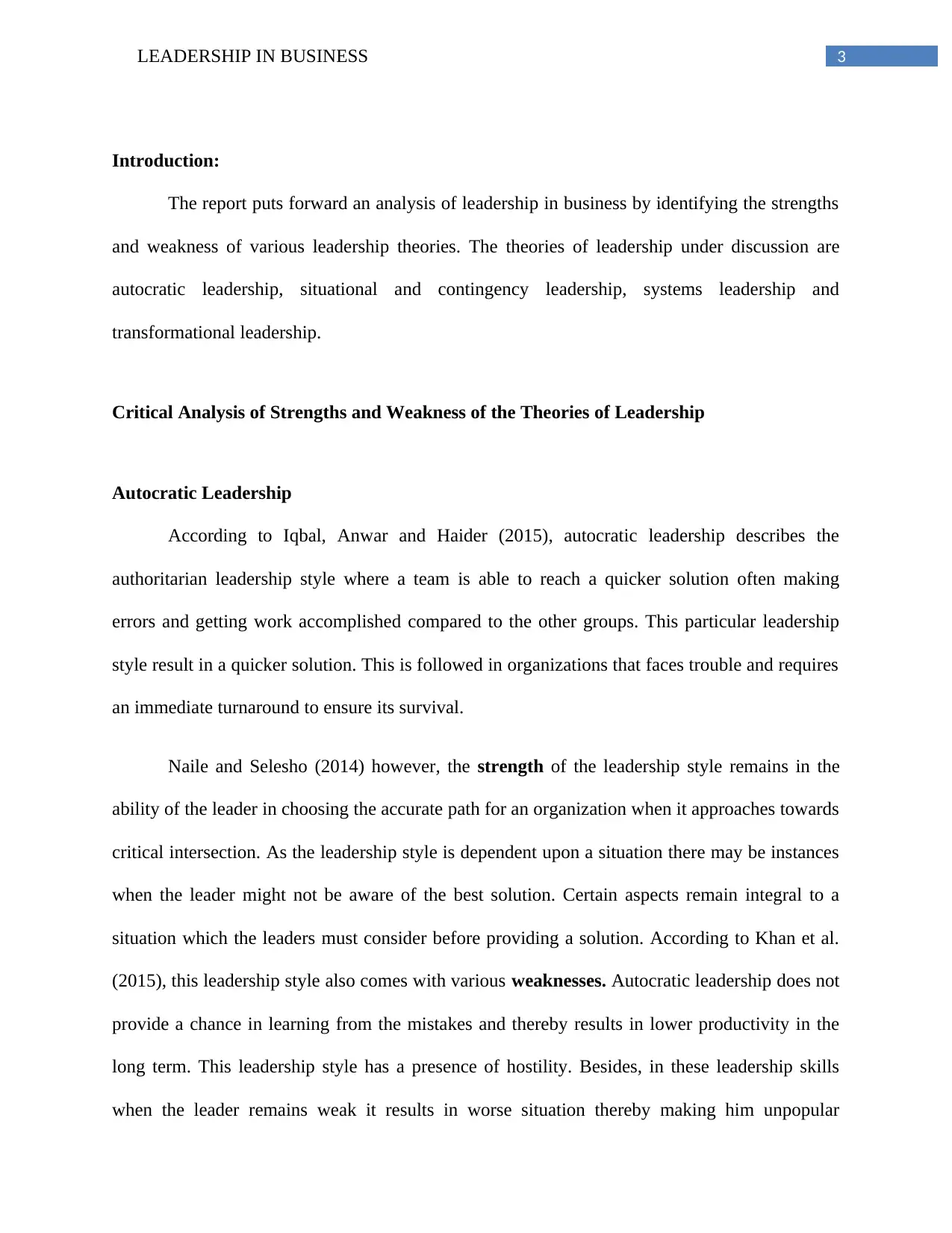
3LEADERSHIP IN BUSINESS
Introduction:
The report puts forward an analysis of leadership in business by identifying the strengths
and weakness of various leadership theories. The theories of leadership under discussion are
autocratic leadership, situational and contingency leadership, systems leadership and
transformational leadership.
Critical Analysis of Strengths and Weakness of the Theories of Leadership
Autocratic Leadership
According to Iqbal, Anwar and Haider (2015), autocratic leadership describes the
authoritarian leadership style where a team is able to reach a quicker solution often making
errors and getting work accomplished compared to the other groups. This particular leadership
style result in a quicker solution. This is followed in organizations that faces trouble and requires
an immediate turnaround to ensure its survival.
Naile and Selesho (2014) however, the strength of the leadership style remains in the
ability of the leader in choosing the accurate path for an organization when it approaches towards
critical intersection. As the leadership style is dependent upon a situation there may be instances
when the leader might not be aware of the best solution. Certain aspects remain integral to a
situation which the leaders must consider before providing a solution. According to Khan et al.
(2015), this leadership style also comes with various weaknesses. Autocratic leadership does not
provide a chance in learning from the mistakes and thereby results in lower productivity in the
long term. This leadership style has a presence of hostility. Besides, in these leadership skills
when the leader remains weak it results in worse situation thereby making him unpopular
Introduction:
The report puts forward an analysis of leadership in business by identifying the strengths
and weakness of various leadership theories. The theories of leadership under discussion are
autocratic leadership, situational and contingency leadership, systems leadership and
transformational leadership.
Critical Analysis of Strengths and Weakness of the Theories of Leadership
Autocratic Leadership
According to Iqbal, Anwar and Haider (2015), autocratic leadership describes the
authoritarian leadership style where a team is able to reach a quicker solution often making
errors and getting work accomplished compared to the other groups. This particular leadership
style result in a quicker solution. This is followed in organizations that faces trouble and requires
an immediate turnaround to ensure its survival.
Naile and Selesho (2014) however, the strength of the leadership style remains in the
ability of the leader in choosing the accurate path for an organization when it approaches towards
critical intersection. As the leadership style is dependent upon a situation there may be instances
when the leader might not be aware of the best solution. Certain aspects remain integral to a
situation which the leaders must consider before providing a solution. According to Khan et al.
(2015), this leadership style also comes with various weaknesses. Autocratic leadership does not
provide a chance in learning from the mistakes and thereby results in lower productivity in the
long term. This leadership style has a presence of hostility. Besides, in these leadership skills
when the leader remains weak it results in worse situation thereby making him unpopular
Paraphrase This Document
Need a fresh take? Get an instant paraphrase of this document with our AI Paraphraser
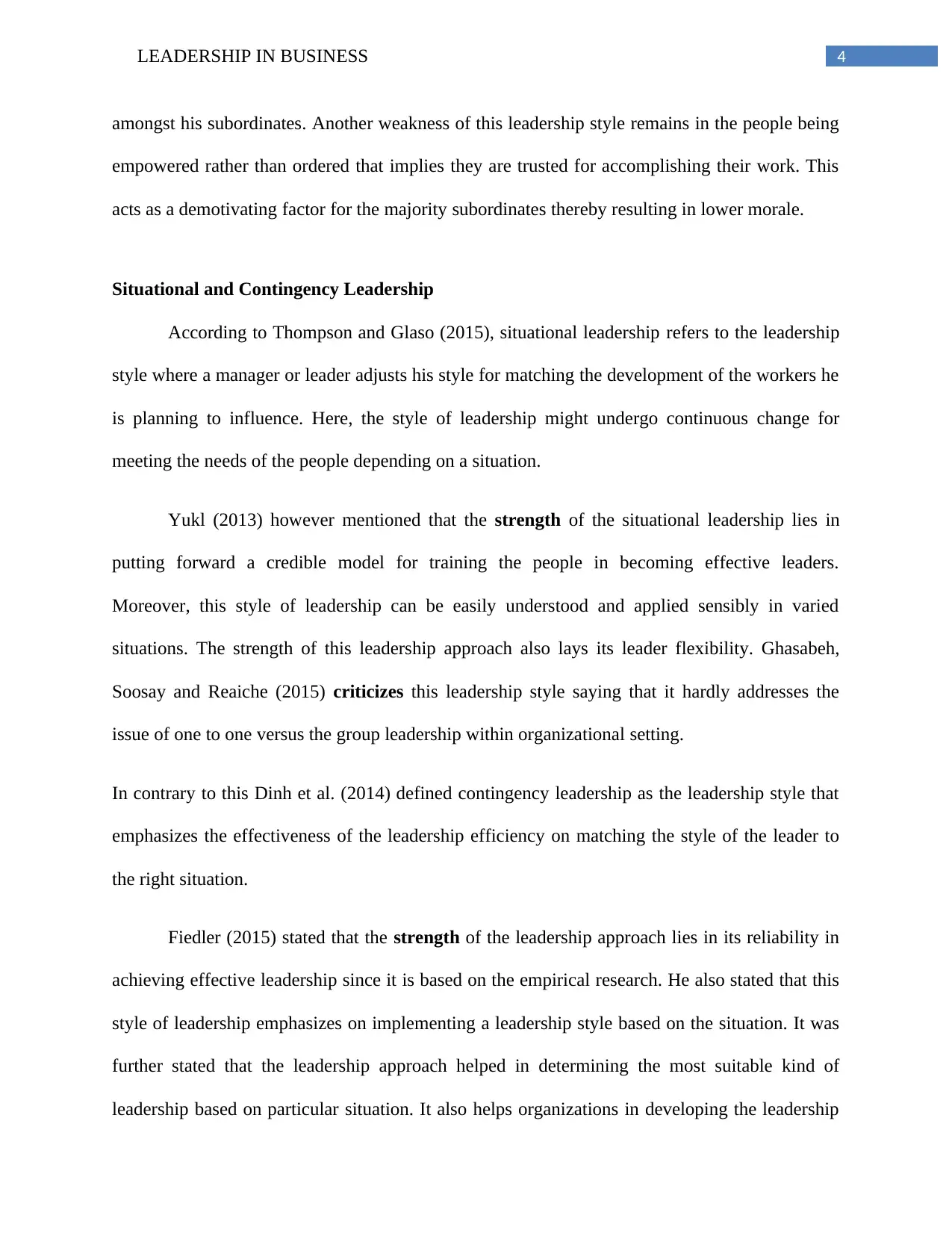
4LEADERSHIP IN BUSINESS
amongst his subordinates. Another weakness of this leadership style remains in the people being
empowered rather than ordered that implies they are trusted for accomplishing their work. This
acts as a demotivating factor for the majority subordinates thereby resulting in lower morale.
Situational and Contingency Leadership
According to Thompson and Glaso (2015), situational leadership refers to the leadership
style where a manager or leader adjusts his style for matching the development of the workers he
is planning to influence. Here, the style of leadership might undergo continuous change for
meeting the needs of the people depending on a situation.
Yukl (2013) however mentioned that the strength of the situational leadership lies in
putting forward a credible model for training the people in becoming effective leaders.
Moreover, this style of leadership can be easily understood and applied sensibly in varied
situations. The strength of this leadership approach also lays its leader flexibility. Ghasabeh,
Soosay and Reaiche (2015) criticizes this leadership style saying that it hardly addresses the
issue of one to one versus the group leadership within organizational setting.
In contrary to this Dinh et al. (2014) defined contingency leadership as the leadership style that
emphasizes the effectiveness of the leadership efficiency on matching the style of the leader to
the right situation.
Fiedler (2015) stated that the strength of the leadership approach lies in its reliability in
achieving effective leadership since it is based on the empirical research. He also stated that this
style of leadership emphasizes on implementing a leadership style based on the situation. It was
further stated that the leadership approach helped in determining the most suitable kind of
leadership based on particular situation. It also helps organizations in developing the leadership
amongst his subordinates. Another weakness of this leadership style remains in the people being
empowered rather than ordered that implies they are trusted for accomplishing their work. This
acts as a demotivating factor for the majority subordinates thereby resulting in lower morale.
Situational and Contingency Leadership
According to Thompson and Glaso (2015), situational leadership refers to the leadership
style where a manager or leader adjusts his style for matching the development of the workers he
is planning to influence. Here, the style of leadership might undergo continuous change for
meeting the needs of the people depending on a situation.
Yukl (2013) however mentioned that the strength of the situational leadership lies in
putting forward a credible model for training the people in becoming effective leaders.
Moreover, this style of leadership can be easily understood and applied sensibly in varied
situations. The strength of this leadership approach also lays its leader flexibility. Ghasabeh,
Soosay and Reaiche (2015) criticizes this leadership style saying that it hardly addresses the
issue of one to one versus the group leadership within organizational setting.
In contrary to this Dinh et al. (2014) defined contingency leadership as the leadership style that
emphasizes the effectiveness of the leadership efficiency on matching the style of the leader to
the right situation.
Fiedler (2015) stated that the strength of the leadership approach lies in its reliability in
achieving effective leadership since it is based on the empirical research. He also stated that this
style of leadership emphasizes on implementing a leadership style based on the situation. It was
further stated that the leadership approach helped in determining the most suitable kind of
leadership based on particular situation. It also helps organizations in developing the leadership
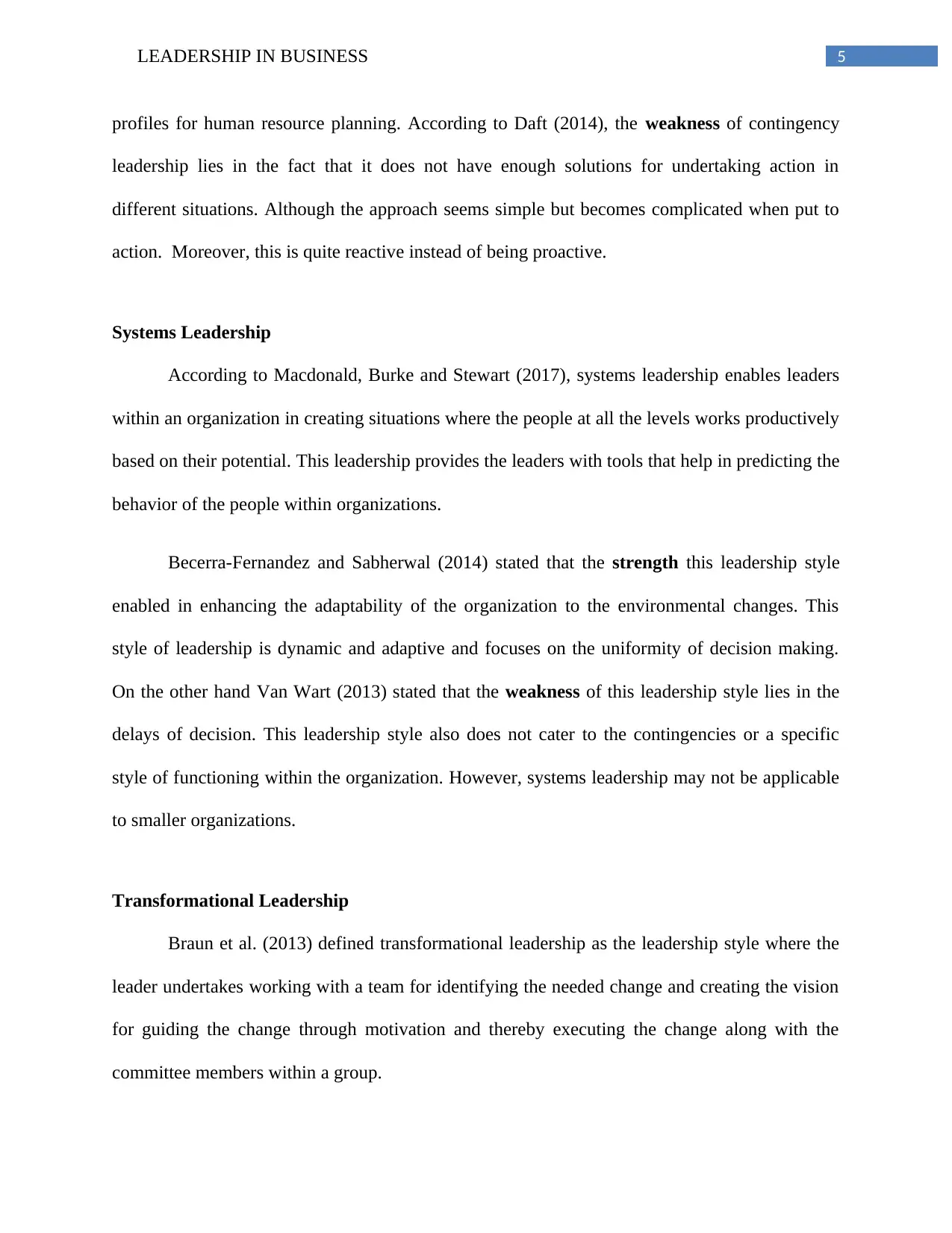
5LEADERSHIP IN BUSINESS
profiles for human resource planning. According to Daft (2014), the weakness of contingency
leadership lies in the fact that it does not have enough solutions for undertaking action in
different situations. Although the approach seems simple but becomes complicated when put to
action. Moreover, this is quite reactive instead of being proactive.
Systems Leadership
According to Macdonald, Burke and Stewart (2017), systems leadership enables leaders
within an organization in creating situations where the people at all the levels works productively
based on their potential. This leadership provides the leaders with tools that help in predicting the
behavior of the people within organizations.
Becerra-Fernandez and Sabherwal (2014) stated that the strength this leadership style
enabled in enhancing the adaptability of the organization to the environmental changes. This
style of leadership is dynamic and adaptive and focuses on the uniformity of decision making.
On the other hand Van Wart (2013) stated that the weakness of this leadership style lies in the
delays of decision. This leadership style also does not cater to the contingencies or a specific
style of functioning within the organization. However, systems leadership may not be applicable
to smaller organizations.
Transformational Leadership
Braun et al. (2013) defined transformational leadership as the leadership style where the
leader undertakes working with a team for identifying the needed change and creating the vision
for guiding the change through motivation and thereby executing the change along with the
committee members within a group.
profiles for human resource planning. According to Daft (2014), the weakness of contingency
leadership lies in the fact that it does not have enough solutions for undertaking action in
different situations. Although the approach seems simple but becomes complicated when put to
action. Moreover, this is quite reactive instead of being proactive.
Systems Leadership
According to Macdonald, Burke and Stewart (2017), systems leadership enables leaders
within an organization in creating situations where the people at all the levels works productively
based on their potential. This leadership provides the leaders with tools that help in predicting the
behavior of the people within organizations.
Becerra-Fernandez and Sabherwal (2014) stated that the strength this leadership style
enabled in enhancing the adaptability of the organization to the environmental changes. This
style of leadership is dynamic and adaptive and focuses on the uniformity of decision making.
On the other hand Van Wart (2013) stated that the weakness of this leadership style lies in the
delays of decision. This leadership style also does not cater to the contingencies or a specific
style of functioning within the organization. However, systems leadership may not be applicable
to smaller organizations.
Transformational Leadership
Braun et al. (2013) defined transformational leadership as the leadership style where the
leader undertakes working with a team for identifying the needed change and creating the vision
for guiding the change through motivation and thereby executing the change along with the
committee members within a group.
⊘ This is a preview!⊘
Do you want full access?
Subscribe today to unlock all pages.

Trusted by 1+ million students worldwide
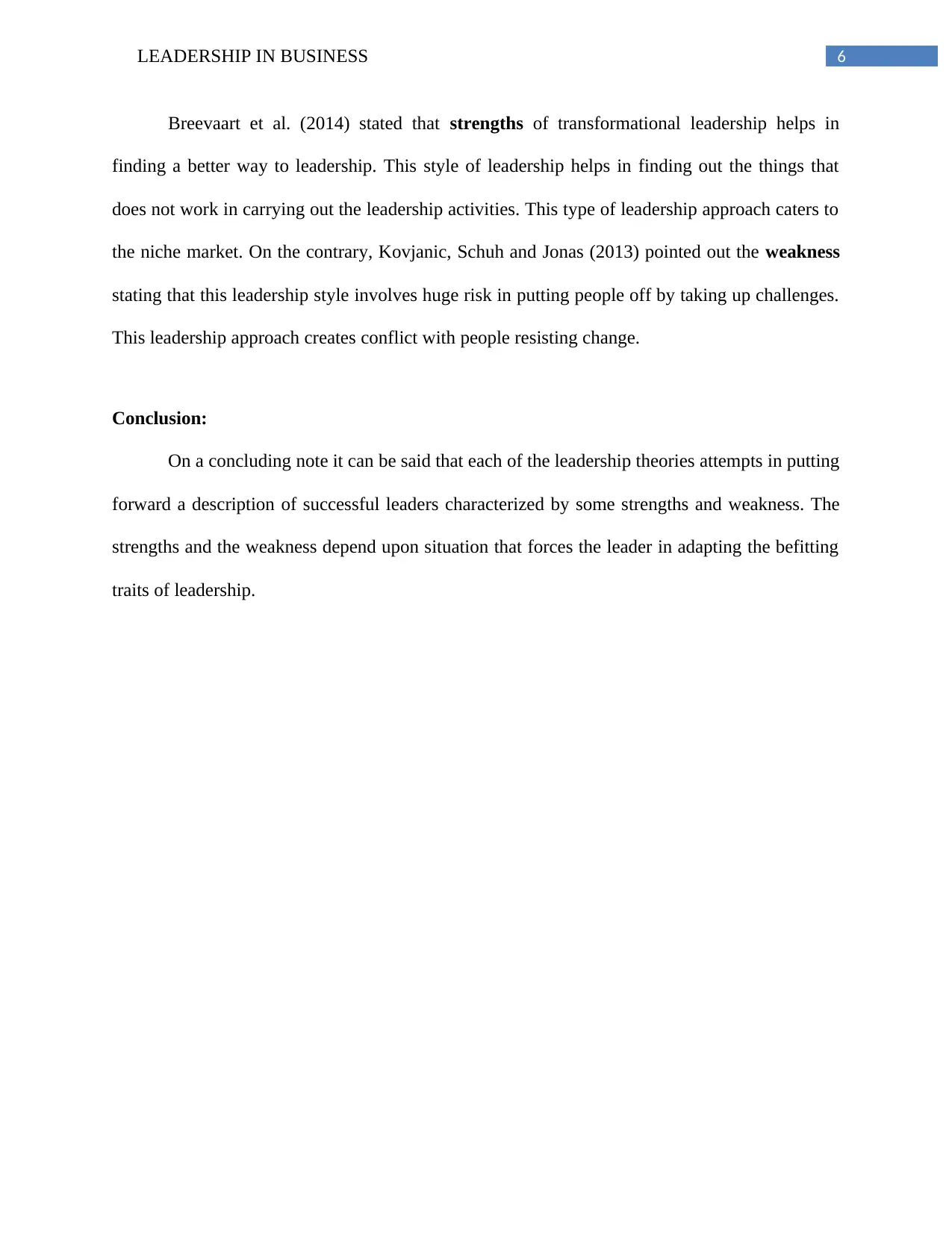
6LEADERSHIP IN BUSINESS
Breevaart et al. (2014) stated that strengths of transformational leadership helps in
finding a better way to leadership. This style of leadership helps in finding out the things that
does not work in carrying out the leadership activities. This type of leadership approach caters to
the niche market. On the contrary, Kovjanic, Schuh and Jonas (2013) pointed out the weakness
stating that this leadership style involves huge risk in putting people off by taking up challenges.
This leadership approach creates conflict with people resisting change.
Conclusion:
On a concluding note it can be said that each of the leadership theories attempts in putting
forward a description of successful leaders characterized by some strengths and weakness. The
strengths and the weakness depend upon situation that forces the leader in adapting the befitting
traits of leadership.
Breevaart et al. (2014) stated that strengths of transformational leadership helps in
finding a better way to leadership. This style of leadership helps in finding out the things that
does not work in carrying out the leadership activities. This type of leadership approach caters to
the niche market. On the contrary, Kovjanic, Schuh and Jonas (2013) pointed out the weakness
stating that this leadership style involves huge risk in putting people off by taking up challenges.
This leadership approach creates conflict with people resisting change.
Conclusion:
On a concluding note it can be said that each of the leadership theories attempts in putting
forward a description of successful leaders characterized by some strengths and weakness. The
strengths and the weakness depend upon situation that forces the leader in adapting the befitting
traits of leadership.
Paraphrase This Document
Need a fresh take? Get an instant paraphrase of this document with our AI Paraphraser
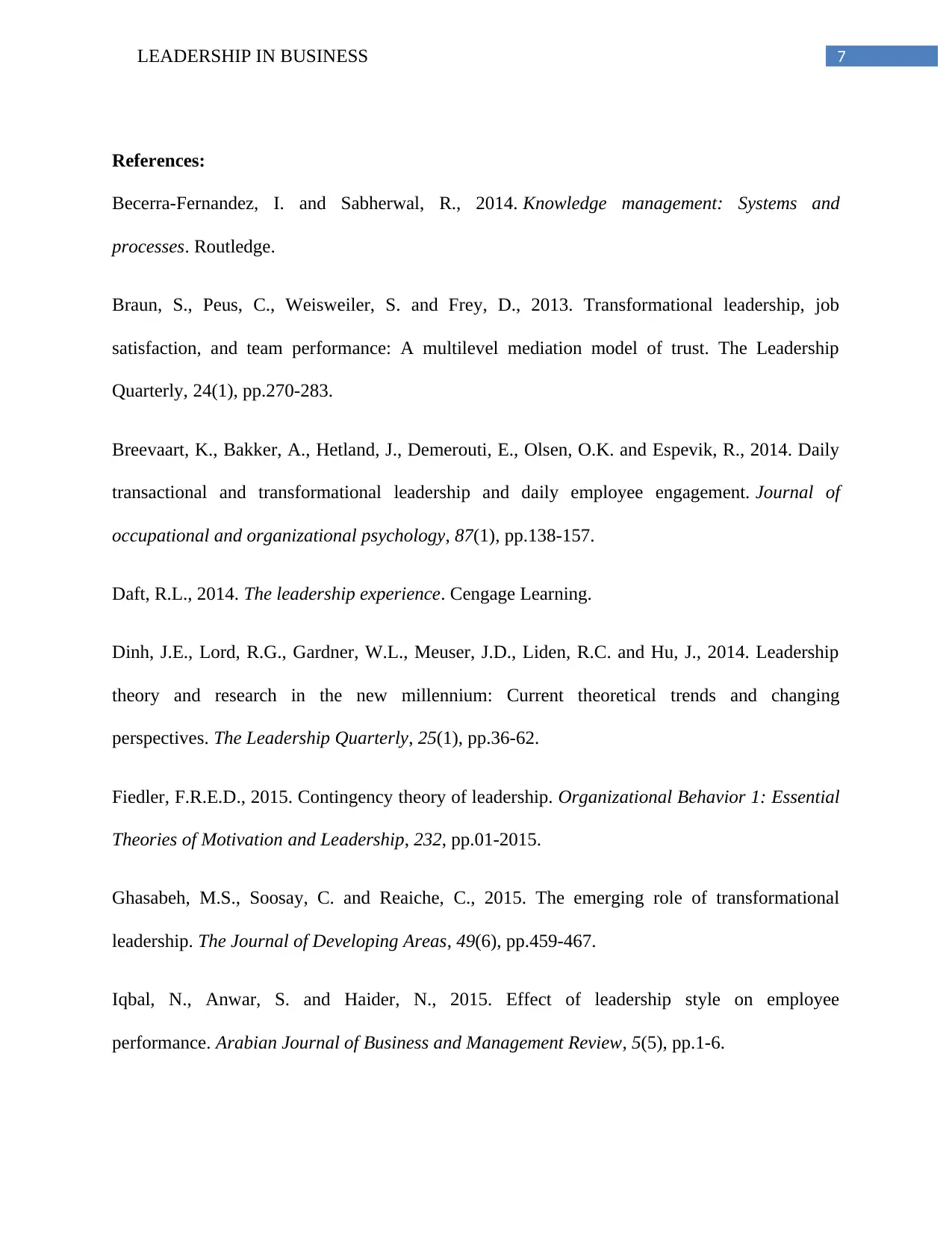
7LEADERSHIP IN BUSINESS
References:
Becerra-Fernandez, I. and Sabherwal, R., 2014. Knowledge management: Systems and
processes. Routledge.
Braun, S., Peus, C., Weisweiler, S. and Frey, D., 2013. Transformational leadership, job
satisfaction, and team performance: A multilevel mediation model of trust. The Leadership
Quarterly, 24(1), pp.270-283.
Breevaart, K., Bakker, A., Hetland, J., Demerouti, E., Olsen, O.K. and Espevik, R., 2014. Daily
transactional and transformational leadership and daily employee engagement. Journal of
occupational and organizational psychology, 87(1), pp.138-157.
Daft, R.L., 2014. The leadership experience. Cengage Learning.
Dinh, J.E., Lord, R.G., Gardner, W.L., Meuser, J.D., Liden, R.C. and Hu, J., 2014. Leadership
theory and research in the new millennium: Current theoretical trends and changing
perspectives. The Leadership Quarterly, 25(1), pp.36-62.
Fiedler, F.R.E.D., 2015. Contingency theory of leadership. Organizational Behavior 1: Essential
Theories of Motivation and Leadership, 232, pp.01-2015.
Ghasabeh, M.S., Soosay, C. and Reaiche, C., 2015. The emerging role of transformational
leadership. The Journal of Developing Areas, 49(6), pp.459-467.
Iqbal, N., Anwar, S. and Haider, N., 2015. Effect of leadership style on employee
performance. Arabian Journal of Business and Management Review, 5(5), pp.1-6.
References:
Becerra-Fernandez, I. and Sabherwal, R., 2014. Knowledge management: Systems and
processes. Routledge.
Braun, S., Peus, C., Weisweiler, S. and Frey, D., 2013. Transformational leadership, job
satisfaction, and team performance: A multilevel mediation model of trust. The Leadership
Quarterly, 24(1), pp.270-283.
Breevaart, K., Bakker, A., Hetland, J., Demerouti, E., Olsen, O.K. and Espevik, R., 2014. Daily
transactional and transformational leadership and daily employee engagement. Journal of
occupational and organizational psychology, 87(1), pp.138-157.
Daft, R.L., 2014. The leadership experience. Cengage Learning.
Dinh, J.E., Lord, R.G., Gardner, W.L., Meuser, J.D., Liden, R.C. and Hu, J., 2014. Leadership
theory and research in the new millennium: Current theoretical trends and changing
perspectives. The Leadership Quarterly, 25(1), pp.36-62.
Fiedler, F.R.E.D., 2015. Contingency theory of leadership. Organizational Behavior 1: Essential
Theories of Motivation and Leadership, 232, pp.01-2015.
Ghasabeh, M.S., Soosay, C. and Reaiche, C., 2015. The emerging role of transformational
leadership. The Journal of Developing Areas, 49(6), pp.459-467.
Iqbal, N., Anwar, S. and Haider, N., 2015. Effect of leadership style on employee
performance. Arabian Journal of Business and Management Review, 5(5), pp.1-6.
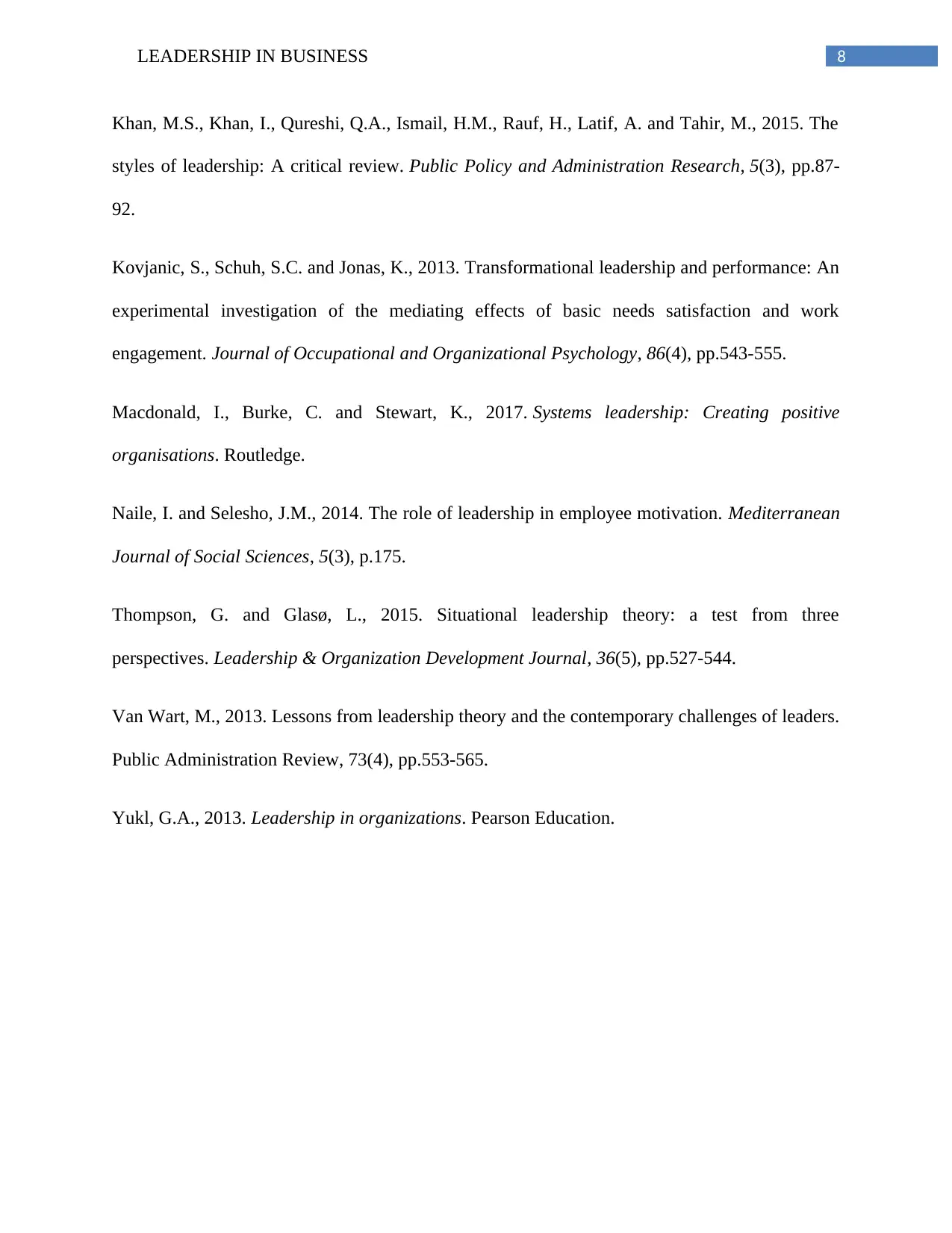
8LEADERSHIP IN BUSINESS
Khan, M.S., Khan, I., Qureshi, Q.A., Ismail, H.M., Rauf, H., Latif, A. and Tahir, M., 2015. The
styles of leadership: A critical review. Public Policy and Administration Research, 5(3), pp.87-
92.
Kovjanic, S., Schuh, S.C. and Jonas, K., 2013. Transformational leadership and performance: An
experimental investigation of the mediating effects of basic needs satisfaction and work
engagement. Journal of Occupational and Organizational Psychology, 86(4), pp.543-555.
Macdonald, I., Burke, C. and Stewart, K., 2017. Systems leadership: Creating positive
organisations. Routledge.
Naile, I. and Selesho, J.M., 2014. The role of leadership in employee motivation. Mediterranean
Journal of Social Sciences, 5(3), p.175.
Thompson, G. and Glasø, L., 2015. Situational leadership theory: a test from three
perspectives. Leadership & Organization Development Journal, 36(5), pp.527-544.
Van Wart, M., 2013. Lessons from leadership theory and the contemporary challenges of leaders.
Public Administration Review, 73(4), pp.553-565.
Yukl, G.A., 2013. Leadership in organizations. Pearson Education.
Khan, M.S., Khan, I., Qureshi, Q.A., Ismail, H.M., Rauf, H., Latif, A. and Tahir, M., 2015. The
styles of leadership: A critical review. Public Policy and Administration Research, 5(3), pp.87-
92.
Kovjanic, S., Schuh, S.C. and Jonas, K., 2013. Transformational leadership and performance: An
experimental investigation of the mediating effects of basic needs satisfaction and work
engagement. Journal of Occupational and Organizational Psychology, 86(4), pp.543-555.
Macdonald, I., Burke, C. and Stewart, K., 2017. Systems leadership: Creating positive
organisations. Routledge.
Naile, I. and Selesho, J.M., 2014. The role of leadership in employee motivation. Mediterranean
Journal of Social Sciences, 5(3), p.175.
Thompson, G. and Glasø, L., 2015. Situational leadership theory: a test from three
perspectives. Leadership & Organization Development Journal, 36(5), pp.527-544.
Van Wart, M., 2013. Lessons from leadership theory and the contemporary challenges of leaders.
Public Administration Review, 73(4), pp.553-565.
Yukl, G.A., 2013. Leadership in organizations. Pearson Education.
⊘ This is a preview!⊘
Do you want full access?
Subscribe today to unlock all pages.

Trusted by 1+ million students worldwide
1 out of 9
Related Documents
Your All-in-One AI-Powered Toolkit for Academic Success.
+13062052269
info@desklib.com
Available 24*7 on WhatsApp / Email
![[object Object]](/_next/static/media/star-bottom.7253800d.svg)
Unlock your academic potential
Copyright © 2020–2025 A2Z Services. All Rights Reserved. Developed and managed by ZUCOL.



